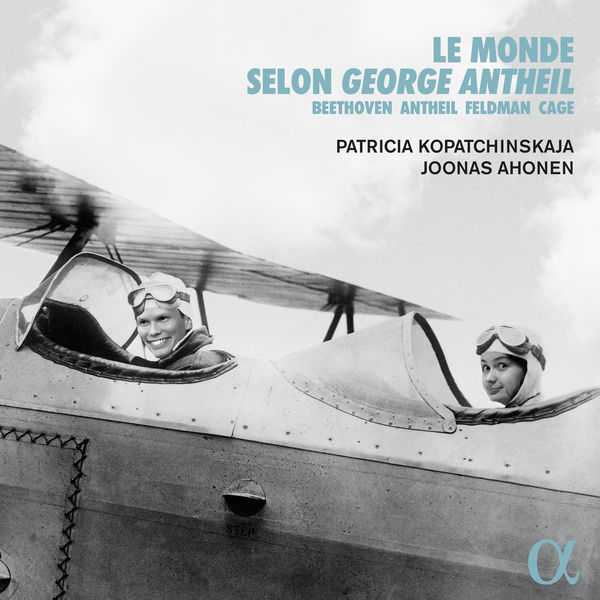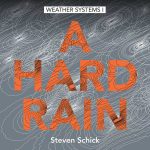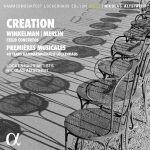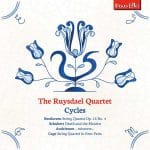

Composer: George Antheil, Ludwig van Beethoven, John Cage, Morton Feldman
Performer: Joonas Ahonen, Patricia Kopatchinskaja
Format: FLAC (tracks)
Label: Alpha
Catalogue: ALPHA797
Release: 2022
Size: 1.08 GB
Recovery: +3%
Scan: yes
01. Feldman: Piece for Violin & Piano
02. Cage: Nocturne
03. Feldman: Extensions 1
Beethoven: Violin Sonata No. 7 in C minor, Op. 30 No. 2
04. I. Allegro con brio
05. II. Adagio cantabile
06. III. Scherzo (Allegro – Trio)
07. IV. Finale (Allegro)
Antheil: Sonata No. 1 for Violin and Piano
08. I. Movement I
09. II. Movement II
10. III. Movement III
11. IV. Movement IV
“Pianist – Futurist” is how American virtuoso pianist George Antheil (1900-1959) once introduced himself. “Bad Boy” or “Wild Child” could just as easily be the tag applied to him. Not just because he was a lover of cars, planes and all things fast and loud, or because his recitals were equally racy, pairing the standard classical repertoire – the first halves of his concerts often featured the music of his hero, Beethoven – with his own explosive creations. Also because, once in Budapest, where his works had caused riots, he returned onstage after the interval and placed upon the piano a loaded, gangster-style 0.32 automatic Colt revolver – after which the concert’s second half was played to respectful silence. Antheil’s European stint also saw him make the most of jazz-age Paris as an accepted member of the avant-garde crowd, jaunts including a trip to the Pleyel piano factory with Stravinsky for a player-piano demonstration of Les noces. Then in 1933 he returned to the US, where he met two of musical indeterminacy’s greatest experimental pioneers, John Cage and Morton Feldman.
In short, the world according to George Antheil was a colourful place, and the programme Patricia Kopatchinskaja has concocted around it is equally colourful: Antheil himself represented by the substantial four-movement Violin Sonata No. 1 he wrote in 1923, joined by Beethoven’s similarly substantial four-movement Violin Sonata No. 7, John Cage’s Nocturne for Violin and Piano (1947), and the whole book-ended by two Morton Feldman works, Piece for Violin and Piano (1950) and Extensions 1 for violin and piano (1951). Add the fact that Kopatchinskaja herself is one of the most colourful violinists of today and, well, no surprises for guessing where this review is heading.
The opening blink-and-you’ve-missed-it Feldman Piece sets the tone, Kopatchinskaja and pianist Joonas Ahonen instantly dropping us into a different, more magical world. Crucially and obviously, there’s the panoply of colour and shadings they’ve brought to its softly floating, slowly evolving, fragmentary lines, a brightly bell-like piano tone here, a cloaked violin whisper there. Equally crucial is how they’re so clearly catching and bouncing off each other – even when weighted silence separates their respective contributions to the dialogue, their thoughts still appear to hang and intermingle in the air. There’s also their realisation of its improvisatory feel, even within an overall sense of deftly handled rhythmic precision.
All of which bodes well for the Antheil Sonata, written for the poet George Crumb’s lifelong love, violinist Olga Rudge. Here, outer movements strike for their percussive, repetitive machine-gun-esque music – played with significant lyricism by Kopatchinskaja, with there as much delicacy in the equation as there is explosive punch – encasing two calmer inner movements featuring Arabic elements and ‘all the strangeness of Africa’ Antheil had experienced on a recent trip to Tunis.
As for the Beethoven, inevitably this isn’t a “safe” reading. Instead – again presenting a panoply of colour and emotional expression – it brings home the reasons why Antheil felt such a connection to this pianist-composer forebear of his, bringing Beethoven’s sound world fascinatingly close to those of the 20th century experimentalists. This is dangerous-sounding Beethoven, Kopatchinskaja and Ahonen bringing out all the music’s volatility, as Kopatchinskaja’s violin by turns grows, stabs, whispers and keens. Still, before anyone leaps to the assumption that this has been accomplished by playing fast and loose with the score, the opposite is in fact the case. Every surprise sforzando, every super-staccato’d phrase, it’s all on the page. In fact, what this actually is, is a masterclass on how an artist can obey the score to the letter while simultaneously making it sound unmistakably their own.



